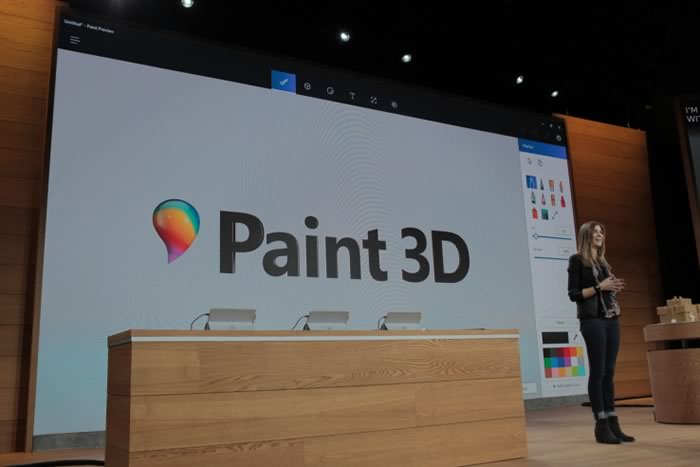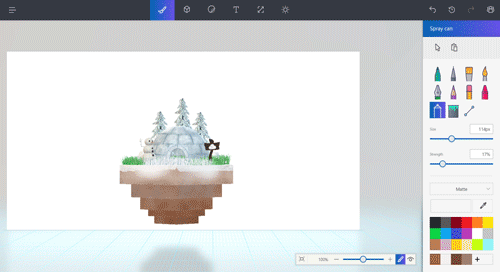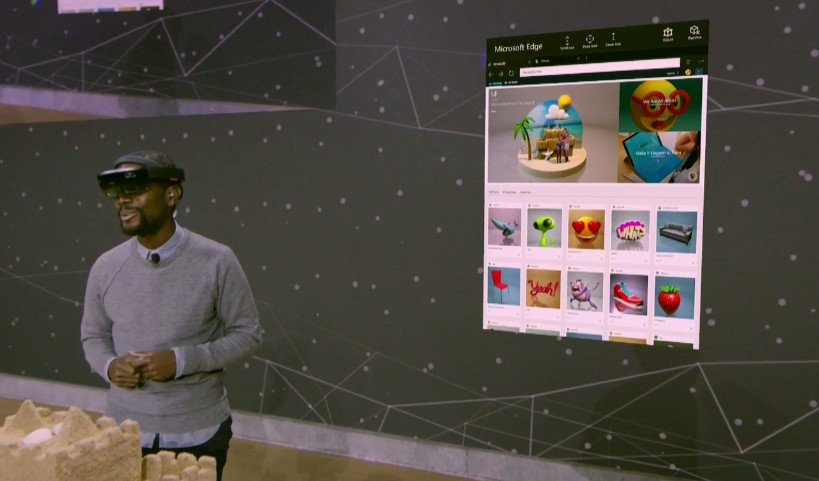If 3D is for everyone, why isn't Microsoft marketing Paint 3D to anyone?
If you didn't know that Microsoft says "3D is for everyone" and that "Paint 3D is your 3D art studio for Windows", you're not alone.

Microsoft is reinventing Windows as a platform for creators via a host of innovations such as Paint 3D. And though Redmond boasted it's bringing 3D to everyone at the October 2016 reveal, consumers don't know that because Microsoft isn't telling them.
Conversely, tech enthusiasts know all about Microsoft's vision for creators which includes Paint 3D, the Fall Creators Update, the innovative Surface devices, HoloLens and mixed reality and the recent Creators Update. Microsoft's Creators Updates are bringing new features to Windows while HoloLens leads the industry's charge into mixed (virtual and augmented) reality.
With these tools, Microsoft's creating a robust platform for creators of varying skill levels. Sadly most "regular" consumers don't know any of this. Even those with the Creators Update may be unaware of Microsoft's reimagining of a Windows classic, Microsoft Paint, with Paint 3D:
Paint 3D makes "creating" on a Windows PC using touch and a pen an entirely new and robust, yet simple experience.
Furthermore, as part of Microsoft's strategy to implement 3D throughout Windows and to bring 3D to everyone it is core to Microsoft's vision for the Creators Updates. It's therefore ironic (even confusing) that Microsoft isn't doing more to promote Paint 3D to consumers.
Microsoft, you get out what you put in
Microsoft's repositioning of Windows as a creators and mixed reality platform, implementing system-wide inking, and refocusing on gaming with game mode and Mixer are a reflection of it's attempt at a renewed commitment to consumers.
Sadly, most consumers have no clue Microsoft has made that commitment. Nor do they realize Windows is being reimagined as a platform to appeal to the creator in all of us.
Get the Windows Central Newsletter
All the latest news, reviews, and guides for Windows and Xbox diehards.
If Microsoft's relying on users discovering new Windows features, and subsequently understanding and then embracing its creators vision, the company may be unpleasantly surprised when that doesn't happen.
Microsoft, you gotta show 'em

Microsoft's challenge as a historically enterprise-focused company is communicating with consumers. According to Chief Marketing Officer Chris Capossela, the company has focused on a marketing strategy which relies on the integration of products as a means to promote other products. Think Skype integration in Office.
This marketing strategy relies on users discovering one product by using another. It's not the aggressive "in your face" marketing method that's needed to introduce consumers to and educate them on Microsoft's expanded vision of Windows-as-a-creators-platform.
Microsoft hasn't abandoned its forte; it's simply positioned new creation tools alongside the familiar productivity-focused tools like Office. Just as Microsoft historically equipped consumers for traditional productivity, it now also sees us as creators and is equipping us accordingly.
Paint 3D is just part of the picture
Ben Reed of Microsoft's Windows Next Generation Experiences Team demonstrates how Microsoft is "enabling the creator in all of us" with Paint 3D in the video below:
Paint 3D's a familiar yet powerful tool that Microsoft can market to introduce its "creators" vision to the masses. This isn't just about Paint 3D, however. It's about Microsoft taking the initiative to tell consumers about Paint 3D, mixed reality, gaming and more which are part of its expanding vision for Windows.
Rather than hoping consumers will discover these new features Microsoft must be proactive in establishing mindshare for each.
And a little child shall lead them
Windows Chief Terry Myerson expressed that the next generation of children inspired the creators vision for Windows.
We're thinking about each of us as creators ... a distinct inspiration has been watching today's younger generation and the trends in how they're embracing computing. My interaction with CAD came when I was in mechanical engineering school. And these kids are so fluent and interactive in really quite rich 3D concepts.
Myerson observed children's affinity for and fluency with complex 3D content creation and sharing. He also shared that children are an indicator for what's coming next in personal computing. Microsoft is, therefore, building features into Windows that are forward-looking and currently relevant as seen here:
The skills displayed by Microsoft's partners in the above video may intimidate those who don't fancy themselves as an artist, musician or some other professional creator. However, whether we're using Windows to create a symphony, painting, sketch, PowerPoint or even a document Microsoft says we're all creators.
How will Microsoft convince the masses of this vision? Windows and Office trickled from the enterprise to homes organically. It was also virtually unchallenged; thus, aggressive marketing wasn't required. That strategy won't work here.
Paint 3D, the bridge to Microsoft's creators vision

In a personal computing past dominated by traditional enterprise and desktop productivity, Microsoft Paint was fun and useful but also intentionally overshadowed by Office. Today, content creation and sharing are parallel to traditional productivity, thus Microsoft's vision ideally gives Paint 3D a front row seat in Windows.
Paint 3D embodies Microsoft's mission to make Windows a creative platform for everyone. It's available to the masses, easy to use, allows 3D creations to be integrated into other products and with Remix 3D, provides a community for users to share creations.
It's an easy onramp to Microsoft's modern vision for Windows. Moreover, as a tool for creating 3D objects, it opens the door to Windows Mixed Reality.
Mainstreaming 3D with smartphones
Microsoft even created a mobile app called Windows Capture 3D Experience. The cross-platform app (with the consumer-unfriendly name) will allow users to scan an object with their phone's camera to create a 3D representation of that object that can be edited, integrated into other programs and shared. Microsoft's General Manager, Megan Saunders, demos this app on an HP Elite x3 in the video below:
The app isn't yet available, but it demonstrates Microsoft's innovative vision. The ability to use smartphones to memorialize 3D representations of experiences and ultimately edit and share them as easily as we routinely do 2D images is a big step forward.
Unfortunately, Microsoft is slow to bring products to consumers and may be beaten to market by rivals.
Appeal to kids, parents will follow
Microsoft needs to become aggressive in making consumers aware of its creators vision and Paint 3D's role in it. Children, the inspiration for the updates, may be the key.
Most parents have experienced their child's incessant begging for some toy or food they saw advertised or a friend has. Advertisers who target children know that by creating demand with kids, adults with purchasing power subsequently become aware of a product and may potentially purchase it.
Microsoft already knows that children have an affinity for creating, manipulating and sharing 3D content. The company needs to appeal to that quality with an aggressive campaign that promotes Paint 3D and Microsoft's creators vision for Windows.
Microsoft's campaign should showcase use cases that appeal to both children and adults as seen in the YouTube video above. Children's demand for the product will increase adult's awareness of the same.
Paint 3D, the path to Windows Mixed Reality
Though informative, Microsoft cannot rely on YouTube videos to convey its vision. The viewers of those videos are primarily techies who search for or happen upon them in tech articles. To reach ordinary consumers, Microsoft must "force" TV commercials in front them.
Additionally, as the herald for Microsoft's 3D-for-everyone strategy, Microsoft's marketing of Paint 3D would be a push for its Windows-as-a-creators-platform and mixed reality vision.
Saunders said of capturing 3D objects from the real world:
Edit it in Paint 3D ... bring it back into your world as a hologram or take it into a virtual world.
Paint 3D is key to Microsoft's strategy to make consumers creators not just viewers of mixed reality content. Given Microsoft's emphasis of mixed reality it is mind-boggling the company is putting so little effort behind marketing Paint 3D.
Jason L Ward is a columnist at Windows Central. He provides unique big picture analysis of the complex world of Microsoft. Jason takes the small clues and gives you an insightful big picture perspective through storytelling that you won't find *anywhere* else. Seriously, this dude thinks outside the box. Follow him on Twitter at @JLTechWord. He's doing the "write" thing!

